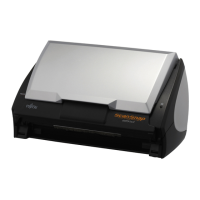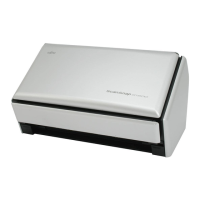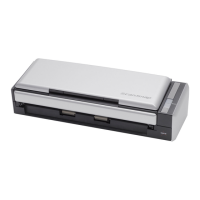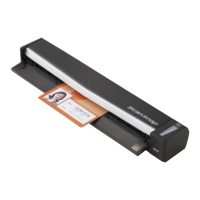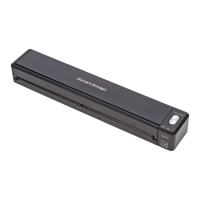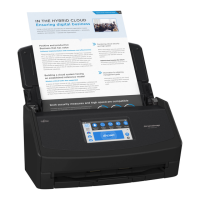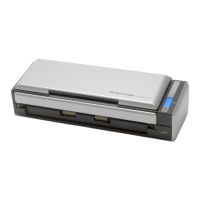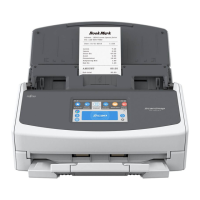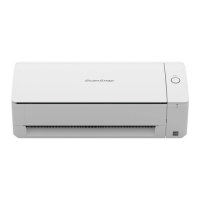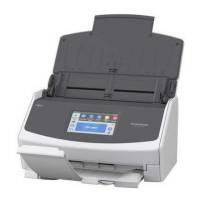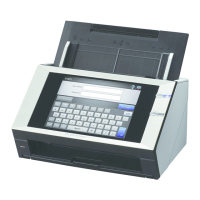
Do you have a question about the Fujitsu ScanSnap N1800 and is the answer not in the manual?
| Film scanning | No |
|---|---|
| Color scanning | Yes |
| Input color depth | - bit |
| Maximum scan size | 216 x 356 mm |
| Output color depth | 24 bit |
| ADF scan speed (color, A4) | 20 ppm |
| Optical scanning resolution | 600 x 600 DPI |
| Duplex ADF scan speed (color, A4) | 20 ipm |
| Display | TFT |
| Scanner type | ADF scanner |
| Product color | Black, Grey |
| Display diagonal | 8.4 \ |
| Display resolution | 1024 x 768 pixels |
| Scan to | E-mail, Fax, File, FTP, Image |
| Sensor type | CCD |
| Scan file formats | JPG, PDF, TIFF |
| Maximum duty cycle | 12000 pages per month |
| Daily duty cycle (max) | 2000 pages |
| Minimum scan area (ADF) | 50.8 x 50.8 mm |
| ISO A-series sizes (A0...A9) | A4, A5, A6, A7, A8 |
| Maximum ISO A-series paper size | A4 |
| Auto Document Feeder (ADF) media weight | 52 - 127 g/m² |
| Auto document feeder (ADF) input capacity | 50 sheets |
| Safety | LDAP, LDAPS, FTPS, HTTPS |
| Cabling technology | 10BASE-T, 100BASE-TX |
| Networking features | Fast Ethernet |
| Supported network protocols | TCP/IP, DHCP, SMTP, SMB, LDAP, NTP, FTP, HTTP |
| Input voltage | 100-240 V |
| Power supply type | AC |
| Power consumption (off) | 0.5 W |
| Power consumption (standby) | 15 W |
| Power consumption (typical) | 50 W |
| Sustainability certificates | ENERGY STAR |
| Operating temperature (T-T) | 5 - 35 °C |
| Operating relative humidity (H-H) | 20 - 80 % |
| Certification | RoHS |
| Depth | 226 mm |
|---|---|
| Width | 300 mm |
| Height | 172 mm |
| Weight | 6000 g |
Explains the manual's structure, including warning and caution symbols used throughout the document.
Describes how to access the Help function from the scanner's touch panel or application windows.
Details basic uses for scanned data, ease of configuration, and advanced security measures.
Identifies and describes the function of front view, rear view, and removable parts of the scanner.
Distinguishes between regular user and administrator rights and lists available operations per login method.
Outlines the software and hardware requirements for using the Admin Tool, Central Admin Console, and Central Admin Server.
Provides instructions on how to safely turn the scanner on and off, including standby mode operations.
Explains the functionality of the Power Button and the Top Cover Scan Button for scanner operations.
Details how to interact with the scanner's LCD touch panel, including precautions for use.
Explains how to show, hide, and use the on-screen keyboard for text input on the LCD touch panel.
Describes methods for scanner configuration and management via LCD touch panel, Admin Tool, and Central Admin Console.
Details necessary settings for functions like e-Mail, Fax, Print, Save, and Scan to SharePoint based on administrator configuration.
Explains administrator windows via LCD Touch Panel and Admin Tool, detailing menu navigation.
Covers administrator login procedures via LCD Touch Panel and Admin Tool, including settings for automatic login.
Guides through configuring system settings using the installation wizard on the LCD touch panel.
Explains how to set the mode (Basic/Advanced) for configuring system settings via the LCD touch panel.
Details system configuration steps including setting scanner name, language, region, date/time, and keyboard.
Covers scan option settings such as multifeed detection, scan starting position, and general scanner settings.
Explains settings related to login, including authentication modes, automatic login, and standby mode.
Details network configuration, including IP address, DNS/WINS server, NTP server, proxy server, and ping tests.
Explains configuration of LDAP servers for user authentication, e-mail lookup, and search parameters.
Covers settings for e-Mail server configuration, sending e-mails, and file name formats for e-mail attachments.
Details the configuration of the fax server, specifically for RightFax.
Describes how to set network, FTP server, and SharePoint folders for saving scanned data.
Provides instructions for setting up network printers, including driver checks and registration.
Explains how to view system status, usage status, installed options, user log, and system log.
Covers maintenance of user data store and system settings, including backup, restore, and factory reset.
Details system maintenance tasks like updating software, managing add-in modules, and obtaining technical support.
Explains how to set job sequences, job menus, and job groups for automating scanning tasks.
Lists common messages displayed to the administrator and their meanings or actions.
Provides an overview of functions available in the Central Admin Console and their corresponding sections.
Describes the main windows and menus available within the Central Admin Console interface.
Offers a step-by-step guide for performing management tasks using the Central Admin Console.
Details pre-installation steps for Central Admin Server software, console, firewall setup, and scanner configuration.
Explains how to log in to the Central Admin Server using the Central Admin Console.
Covers setting up the Central Admin Server environment, including operating environment, password, network, and LDAP server.
Describes adding, editing, deleting, importing, exporting, and viewing scanner configurations.
Explains how to monitor and maintain the scanner network, including viewing status and event logs.
Details how to update scanner system software, security, and installed options via the Central Admin Console.
Provides instructions for installing, uninstalling, and managing Add-in modules via the Central Admin Console.
Explains how to update scanner settings, including uploading new sets and issuing update calls.
Covers setting job modes and release schedules, and configuring job mode settings for scanners.
Describes how to view the status of system updates, add-in installations, and scanner settings.
Explains how to monitor the operating status of scanners, including online, offline, and error states.
Details how to view, download, and clear event logs from scanners and the Central Admin Server.
Covers collecting and exporting audit logs for system and user operations for auditing purposes.
Explains procedures for backing up, restoring, obtaining technical support, and migrating Central Admin Server settings.
Lists messages that may appear during central admin operations, including connection errors and window display issues.
Provides instructions on how to load documents into the ADF paper chute, including handling multiple sheets and carrier sheets.
Explains the Main Menu and Job Menu windows as seen by regular users.
Details the login process for regular users, including LDAP and local account authentication.
Guides on sending scanned data via e-mail, including addressing, file naming, and scan viewer settings.
Explains how to send scanned data by fax, including entering fax numbers and managing contacts.
Covers printing scanned data, including selecting printers, scaling, positioning, and print side settings.
Details how to save scanned data to network or FTP server folders, including file naming and overwriting options.
Explains how to save scanned data to SharePoint folders, including folder selection, authentication, and property settings.
Covers various scan settings like carrier sheet, color mode, resolution, file format, and text recognition.
Describes how to enable or disable the Scan Viewer that appears before scanned data processing.
Explains how to view, rotate, sort, scan additional pages, delete pages, and edit marked characters in the Scan Viewer.
Details how to check the user operation logs, which record activities performed by the current user.
Covers maintenance operations such as editing e-mail addresses, fax numbers, roller cleaning, and scan tests.
Explains how to process jobs using the Job Menu, including message screen and scan count settings.
Provides instructions on how to change the password for a user account registered locally on the scanner.
Lists recommended cleaning supplies and their part numbers for scanner maintenance.
Details how to clean the scanner's exterior parts, including the LCD touch panel, using appropriate materials.
Provides instructions for cleaning the internal parts of the scanner, including glass, rollers, and sensors.
Explains how to clean the carrier sheet to maintain scanning performance and prevent malfunctions.
Lists parts that require replacement, their part numbers, and replacement cycles, such as PAD ASSY and PICK ROLLER.
Describes how to perform a scan test after cleaning or replacing parts to ensure scanner functionality.
Guides on calibrating the LCD touch panel to ensure accurate response alignment with screen objects.
Provides procedures for safely removing jammed documents from the scanner's ADF paper chute.
Offers solutions for common network connection problems, including basic tests and specific error scenarios.
Addresses various scanning problems like scanner not turning on, data not scanning properly, or login issues.
Lists information to check before contacting support, including general details and error status.
Shows the location and examples of scanner labels containing model and compliance information.
Outlines preparations before sending the scanner for maintenance, including backing up data and settings.
Specifies the scannable paper sizes, including standard and custom options.
Details recommended paper types and weights, and precautions for scanning various document types.
Provides a graph and table showing the maximum document loading capacity based on paper size and weight.
Identifies the shaded area on documents where holes can cause ADF feed problems.
Explains conditions for multifeed detection based on document layer, length, and other factors.
Details paper sizes, quality, and precautions for using the carrier sheet with the scanner.
Provides guidelines for setting e-mail addresses, including format, allowed characters, and IP address ranges.
Describes the format requirements for scanner configuration files used for importing and exporting.
Lists pre-registered root certificate authorities for SSL communication and their validity periods.
Provides technical specifications for scanner installation, including dimensions, weight, keyboard, and network interface.
Details basic scanner specifications such as scanner type, image sensor, light source, scannable area, and paper weight.
Explains how to switch keyboard layouts (alphabetic/numeric) and change the case of characters.
Introduces User Editor and its capabilities for editing mail address books and local accounts.
Lists the software and hardware requirements for installing and using User Editor.
Details pre-installation steps for User Editor, including accessing the scanner via a web browser and entering login credentials.
Describes the User Editor window structure, including the Address Book and Local Account tabs.
Provides instructions on how to start and exit the User Editor application.
Explains how to load mail address books and local accounts from the scanner or a file.
Covers editing e-mail targets, including adding, changing, and deleting groups and distribution lists.
Details how to add, edit, and delete local accounts for scanner authentication.
Explains how to discard edited information and restore mail address books or local accounts to their original state.
Covers saving edited mail address book or local account information to the scanner or a file.
Describes how User Editor operations are logged and viewed in the user log.
